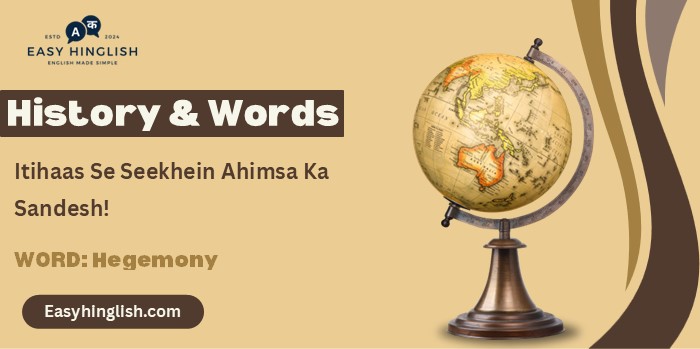History & Words: 'Hegemony' (October 18)
Welcome to 'History & Words.' Main Prashant hoon, Wordpandit aur Learning Inc. Network ka sansthapak. Yeh series meri bhasha seekhne ki lagan aur itihas ke prati ruchi ka sangam hai. Har kadi ek shabd aur uss se judi ek tithi par roshni daalti hai, jisse aapka shabdkosh badhta hai aur aap itihas ko gehraai se samajh paate hain. Aaiye, iss safar mein shabdon ke madhyam se samay mein pichhe chalein.
🔍 Word of the Day: Hegemony
Pronunciation: /hɪˈdʒɛməni/ (hi-JEM-uh-nee)
🌍 Parichay (Introduction)
18 October 1748 ko Aix-la-Chapelle (aaj ka Aachen, Germany) mein Europe ke most powerful nations ne signatures put kiye ek treaty par jo continental power balance ko reshape kar dega. Treaty of Aix-la-Chapelle ne War of Austrian Succession ko end kiya, lekin iska asli significance hegemony ke new patterns establish karne mein tha.
Hegemony – dominant influence ya authority one group ka others par – yeh treaty mein clearly visible tha. Britain ne naval supremacy confirm ki, Austria ne territorial integrity maintain ki, aur France ko recognize karna pada ki European balance mein uska position shift ho raha hai. Yeh sirf border redraw nahi tha – yeh power ka redistribution tha.
October 18, 1748 hegemonic transition ka critical moment tha jab old power structures ne new realities ko accommodate kiya. Treaty ne prove kiya ki hegemony never permanent hai – constantly contested aur renegotiated hoti hai.
🌱 Shabd ka Utpatti (Etymology)
"Hegemony" Greek word "hegemon" se aaya hai, meaning "leader" ya "guide". Original context mein hegemon wo city-state tha jo alliance ya confederation lead karta tha, lekin other members ki autonomy respect karta tha. Athens aur Sparta classic examples the Greek hegemony ke.
Modern political science mein Antonio Gramsci ne hegemony concept develop kiya 20th century mein. Unka analysis economic dominance se beyond tha – cultural, ideological influence include karta tha. Hegemony sirf force nahi, consent through achieved hoti hai.
18th century mein hegemony primarily military aur economic terms mein understand hoti thi. Today soft power, cultural influence, technological dominance bhi hegemonic tools hain.
📖 Mahatvapurn Shabdavali (Key Vocabulary)
- 🔑 Balance of Power: Multiple nations ke beech equal strength maintain karna
- 🔑 Sovereignty: State ki supreme authority apne territory aur people par
- 🔑 Diplomacy: International relations through negotiation rather than force
- 🔑 Sphere of Influence: Region where one nation has dominant control
- 🔑 Alliance System: Formal agreements between nations for mutual support
🏛️ Itihasik Sandarbh (Historical Context)
War of Austrian Succession (1740-1748) Maria Theresa ke Habsburg succession ko challenge karne se start hua. Frederick the Great ne Silesia invade kiya, France ne Austria ko weaken karne ka opportunity dekha, aur Britain ne French expansion contain karne ki strategy follow ki.
Yeh war first truly global conflict tha – Europe se lekar North America (King George's War), Caribbean, aur India tak fighting hui. Different theaters mein different powers dominant the, creating complex web of victories aur defeats.
Britain ka naval power decisive factor tha. Royal Navy ne French commerce ko strangle kiya aur colonial territories secure kiye. Battle of Fontenoy (1745) mein French ne tactical victory achieve ki, lekin strategic advantage Britain ke pass raha.
Austria surprisingly resilient tha. Maria Theresa ne Hungarian support secure kiya famous appeal: "Moriamur pro rege nostro Maria Theresa" (Let us die for our king, Maria Theresa). Austrian hegemony Central Europe mein intact raha.
Treaty negotiations complex the kyunki every power different objectives tha. Britain colonial expansion chahta tha, France European dominance, Austria territorial integrity, Prussia Silesia retention.

⏳ Samayrekha (Timeline)
- 1740: Maria Theresa becomes Archduchess, war begins
- 1741: Frederick invades Silesia
- 1743: Battle of Dettingen, British victory
- 1745: Battle of Fontenoy, French tactical victory
- 1746: Battle of Culloden ends Jacobite rebellion
- 1748: Preliminary peace negotiations
- October 18, 1748: Treaty of Aix-la-Chapelle signed
🌟 Is Din ka Mahatva (The Day's Significance)
October 18, 1748 ko Congress of Aix-la-Chapelle mein representatives of Britain, France, Austria, Spain, Netherlands, Sardinia, aur Modena ne final signatures put kiye. Treaty provisions carefully balanced the each power ki hegemonic aspirations ko manage karne ke liye.
Key provisions ne status quo ante bellum largely restore ki – most conquered territories original owners ko return kar diye gaye. Lekin exceptions significant the: Frederick ne Silesia retain kiya, confirming Prussian rise as European power. Austrian hegemony Germanic lands mein challenge ho gayi permanently.
Maria Theresa ko Holy Roman Empress ke roop mein recognize kiya gaya, lekin her husband Francis Stephen technically emperor bana. Pragmatic Sanction finally accepted ho gayi female succession allow karne ke liye.
Colonial clauses particularly important the future hegemonic struggles ke liye. Louisbourg (captured by British) France ko return kar diya gaya exchange mein Madras (captured by French) ke liye. Yeh arrangement temporary tha – both sides future conflicts ki preparation kar rahe the.
British hegemony seas par confirmed ho gayi. Asiento (slave trade contract) continue raha, British merchants ko Spanish American markets mein access deta hua. Royal Navy ka dominance undisputed tha.
Treaty ne "balance of power" ka principle establish kiya jo next century European diplomacy guide karega. No single power continental hegemony achieve kar sakta tha – others would automatically alliance form kar lete.
💬 Prasiddh Ukti (Quote)
"The balance of power is the scale on which the fate of nations most frequently turns."
— Sir Winston Churchill (reflecting on 18th-century European diplomacy)
🔮 Aaj Ka Matlab aur Chintan (Modern Usage and Reflection)
Modern world mein hegemony much more complex hai than 18th century. American hegemony post-WWII economic, military, cultural, technological dominance through established hua. Dollar as reserve currency, Hollywood, Silicon Valley, military bases globally – yeh sab hegemonic tools hain.
China ka rise hegemonic transition suggest karta hai similar to Prussia ka rise 1748 mein. Belt and Road Initiative, technological advancement, economic integration – new forms of hegemonic projection hain.
Soft power modern hegemony ka crucial component hai. Cultural influence, language dominance, educational systems – yeh sab consent manufacturing mein role play karte hain Gramsci ke theory ke according.
🏛️ Virast (Legacy)
Treaty of Aix-la-Chapelle ka greatest legacy balance of power principle hai jo modern international relations ka foundation hai. Concert of Europe, League of Nations, United Nations – sab attempt kiye hain hegemonic dominance prevent karne ki.
Diplomatic precedent significant tha. Multilateral negotiations, territorial exchanges, guarantee systems – modern treaty-making ke techniques establish hue. International law ka development yahan se start hua.
🔍 Tulnatmak Vishleshan (Comparative Analysis)
1748 mein hegemony primarily military aur territorial terms mein defined thi. Economic factors important the lekin secondary. Today hegemony multidimensional hai – economic, technological, cultural, informational dominance equally important hai military power ke saath.
18th century mein hegemonic change centuries mein happen hoti thi. Modern times mein technological advancement ne pace accelerate kar diya hai – decades mein major shifts possible hain.
💡 Kya Aapko Pata Hai? (Did You Know?)
🎓 Antim Vichar (Conclusion)
October 18, 1748 ne hegemony ko static concept se dynamic process mein transform kar diya. Treaty of Aix-la-Chapelle ne show kiya ki power constantly shifting hai, aur successful hegemony adaptation aur compromise require karta hai. Modern world mein hegemonic transitions continue hote rahte hain, lekin basic principles – balance, negotiation, mutual recognition – same remain karte hain. History humein sikhaata hai ki hegemony temporary hai, lekin institutions aur norms jo peaceful transitions enable karte hain, woh lasting impact create kar sakte hain.
📚 Aage Padhne Ke Liye (Further Reading)
- 📘 The Pursuit of Power: Europe 1815-1914 – Richard J. Evans
- 📗 Hegemony and Socialist Strategy – Ernesto Laclau & Chantal Mouffe
- 📙 The Rise and Fall of the Great Powers – Paul Kennedy








